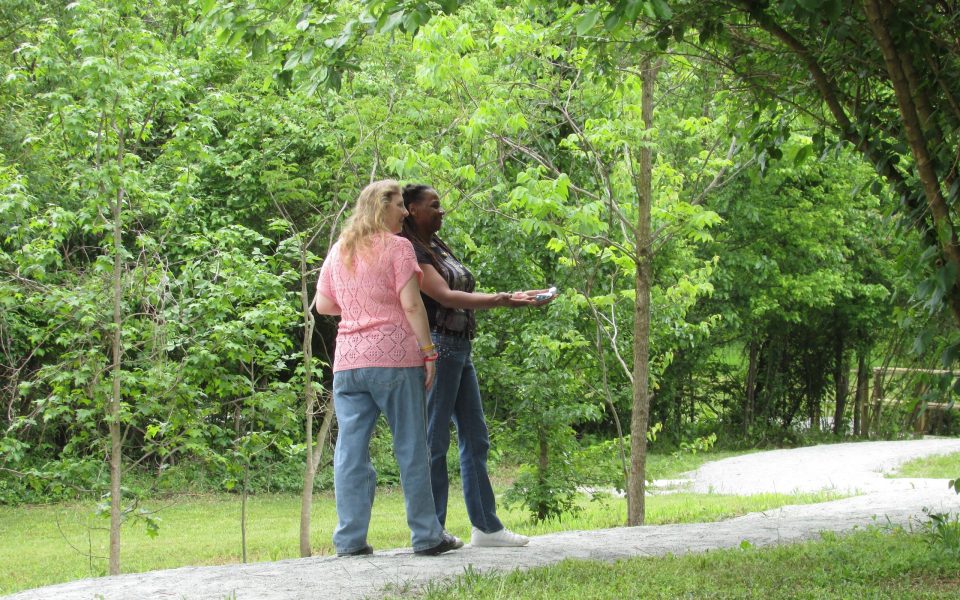by Jordan Green
A nature preserve with a walking trail in southwest High Point that is owned by Guilford County will someday yield a harvest of berries, grapes, figs, pecans, plums and persimmons for local residents.
When Deboraha Stafford worked at Thomas Built Buses, she became the de facto event planner, organizing company picnics. She took early retirement after 15 years so she could care for her husband, who has since passed away, but the High Point resident still feels a strong affinity with the company.
“Anything that’s got to do with Thomas Built I’ve got to check out,” Stafford said.
So when Stafford heard about the grand opening of the Thomas Built Bus Nature Preserve & Urban Orchard on May 9, she knew she had to be there. Stafford and her friend Lisa Hopper, who also lives in High Point, had a Mother’s Day breakfast to attend at Kernersville Church of Christ, but they came to the new urban orchard as soon as they could.
“This is a wonderful thing they’re doing for the community,” Hopper said as she inspected a young Niagara grape plant.
Guilford County purchased the property in the southwest quadrant of High Point for $100,000 from bus manufacturer Thomas Built in 2013 during a period when the county took advantage of recessionary real-estate values to go on a buying spree and acquire land for its open space program. Last September, the county parks department began cleaning up the property to prepare it for public use.
Thomas Built Buses previously used the 6-acre tract to store buses, said Matt Wallace, a parks supervisor with the county. The property fronts onto Potts Avenue across the street from Oak Hill Elementary. A narrow corridor runs between two residential properties before opening into the back to what is now a meadow with a walking trail surrounded by groves of berries, orchards and nut trees.
Brenda Thompson, who has lived in the neighborhood for 40 years, and her sister, Pat Hinesley, own the houses that flank the trail into the orchard. At one point, a developer wanted to build an apartment complex on the lot, but — happily for Thompson — the High Point City Council turned down the rezoning request.
Thompson recalled that her children and grandchildren, who are all grown now, used to play baseball in the Thomas Built lot. The company gradually stopped using the land because of vandalism.
Before the county started cleaning up the lot, it was a haven for snakes and drug deals, Wallace said.
“Today, what you see is open space for urban agriculture and wildlife habitat,” he said. “Even more than that, it’s a tremendous educational opportunity for the community. We have the different types of plants in clusters so the school children can learn about them; they might want to plant a blueberry bush at home. The produce is 100 percent for the community, but we’re not just providing produce but we’re also providing an educational value.”
Each of the food groves is marked with a sign painted by the first graders and kindergarteners at Oak Hill Elementary. Blackberry bushes fill the southeast corner. Nearby is a patch of blueberries. The starts of Black Mission and Brown Turkey fig trees populate the southwest corner, with a Cape Fear pecan sapling positioned behind them. Just up the path is a patch of grapes — Niagara (green) and Fredonia (purple). Over in the northwest corner of the plot, plum and persimmon trees commingle.
The county’s development of the public orchard is only one manifestation of a groundswell of interest in urban agriculture in High Point and across the Triad. Independently of the county, a broad coalition of church leaders, academics, farmers and public servants formed the Greater High Point Food Alliance last year to address food insecurity in the city. The urban agriculture committee of the food alliance began discussing the idea of planting food forests that would yield fruit and nuts, while requiring minimal maintenance, in the Southside neighborhood, which is part of the southwest quadrant. Wendy Fuscoe, a city employee who is a member of the committee, said Matt Wallace came to speak with the committee about the county initiative.
Fuscoe said the Greensboro-High Point metro area’s recent designation as No. 1in food hardship appears to have gotten the attention of the prosperity & livability committee of High Point City Council.
“The prosperity & livability committee has heard rumblings in our community that they want to see changes in our ordinances pertaining to urban agriculture,” said Fuscoe, who serves as core-city administrator for High Point. “By Aug. 1 they want to hear back on what works and what doesn’t.”
Other cities are moving in a similar direction.
Heeding the recommendation to remove barriers to urban food production in its Legacy 2030 plan, Winston-Salem City Council voted on May 4 to amend the city’s urban-agriculture ordinance. The city council voted unanimously to lift a prohibition on agricultural production as a “stand-alone use” on small lots. The city already allows gardening as an “accessory use” — secondary to a primary residence, business or institution — and will continue to do so. A racially diverse group of residents who turned out to support the amendment testified that there is already an enthusiastic cohort of people in the Twin City that are using gardening to supplement their food needs in areas that lack quality and affordable grocery stores.
In High Point, Fuscoe said one possibility for promoting urban agriculture might be to identify city-owned vacant lots and make them available for community gardening.
The urban agriculture committee of the Greater High Point Food Alliance, which mostly acts as a clearinghouse for information, ideas and contacts, has taken at least one concrete step to promote food production. With the help of Mike McNair, the city’s community development director, the committee identified a piece of land near the Southside Community Center and Fairview Elementary to plant a food forest. Ross Lackey, a member of the committee, drew up a schematic with pecan trees, chestnut trees and berry patches. Fuscoe said they took the idea to the Southside community, and got an enthusiastic response. Residents talked about how the area used to have an apple orchard and about an active tradition of home canning. They modified Lackey’s schematic with their own preferences, and Fuscoe said the food forest will be installed soon.
While applauding the various efforts to grow food in the city, Fuscoe injected a note of realism. What’s really needed to address the metro area’s food-hardship challenges, she said, is jobs that pay a living wage. “Sure, it can’t hurt to have edible gardens,” she said. “It can only be positive. Don’t be fooled that that’s going to be the be-all-end-all to food security. That would be naïve.”
Join the First Amendment Society, a membership that goes directly to funding TCB‘s newsroom.
We believe that reporting can save the world.
The TCB First Amendment Society recognizes the vital role of a free, unfettered press with a bundling of local experiences designed to build community, and unique engagements with our newsroom that will help you understand, and shape, local journalism’s critical role in uplifting the people in our cities.
All revenue goes directly into the newsroom as reporters’ salaries and freelance commissions.





Leave a Reply